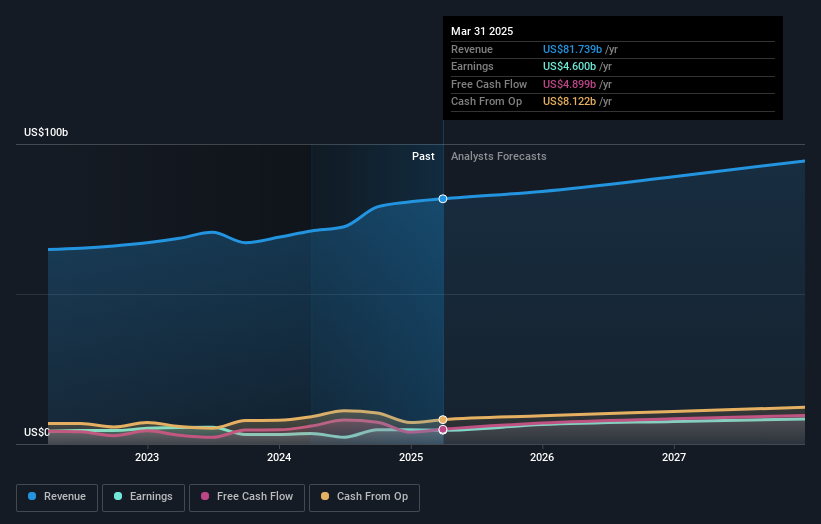
As you might know, RTX Corporation (NYSE:RTX) just kicked off its latest first-quarter results with some very strong numbers. The company beat expectations with revenues of US$20b arriving 2.6% ahead of forecasts. Statutory earnings per share (EPS) were US$1.14, 7.1% ahead of estimates. Earnings are an important time for investors, as they can track a company's performance, look at what the analysts are forecasting for next year, and see if there's been a change in sentiment towards the company. With this in mind, we've gathered the latest statutory forecasts to see what the analysts are expecting for next year.

Following the latest results, RTX's 21 analysts are now forecasting revenues of US$84.2b in 2025. This would be an okay 3.0% improvement in revenue compared to the last 12 months. Statutory earnings per share are predicted to bounce 39% to US$4.80. Before this earnings report, the analysts had been forecasting revenues of US$84.2b and earnings per share (EPS) of US$4.94 in 2025. The analysts seem to have become a little more negative on the business after the latest results, given the minor downgrade to their earnings per share numbers for next year.
Check out our latest analysis for RTX
It might be a surprise to learn that the consensus price target was broadly unchanged at US$140, with the analysts clearly implying that the forecast decline in earnings is not expected to have much of an impact on valuation. Fixating on a single price target can be unwise though, since the consensus target is effectively the average of analyst price targets. As a result, some investors like to look at the range of estimates to see if there are any diverging opinions on the company's valuation. The most optimistic RTX analyst has a price target of US$160 per share, while the most pessimistic values it at US$120. With such a narrow range of valuations, the analysts apparently share similar views on what they think the business is worth.
Another way we can view these estimates is in the context of the bigger picture, such as how the forecasts stack up against past performance, and whether forecasts are more or less bullish relative to other companies in the industry. We would highlight that RTX's revenue growth is expected to slow, with the forecast 4.0% annualised growth rate until the end of 2025 being well below the historical 8.8% p.a. growth over the last five years. By way of comparison, the other companies in this industry with analyst coverage are forecast to grow their revenue at 7.0% per year. So it's pretty clear that, while revenue growth is expected to slow down, the wider industry is also expected to grow faster than RTX.
The Bottom Line
The most important thing to take away is that the analysts downgraded their earnings per share estimates, showing that there has been a clear decline in sentiment following these results. On the plus side, there were no major changes to revenue estimates; although forecasts imply they will perform worse than the wider industry. There was no real change to the consensus price target, suggesting that the intrinsic value of the business has not undergone any major changes with the latest estimates.
Keeping that in mind, we still think that the longer term trajectory of the business is much more important for investors to consider. At Simply Wall St, we have a full range of analyst estimates for RTX going out to 2027, and you can see them free on our platform here..
That said, it's still necessary to consider the ever-present spectre of investment risk. We've identified 3 warning signs with RTX (at least 1 which is concerning) , and understanding these should be part of your investment process.
Have feedback on this article? Concerned about the content? Get in touch with us directly. Alternatively, email editorial-team (at) simplywallst.com.
This article by Simply Wall St is general in nature. We provide commentary based on historical data and analyst forecasts only using an unbiased methodology and our articles are not intended to be financial advice. It does not constitute a recommendation to buy or sell any stock, and does not take account of your objectives, or your financial situation. We aim to bring you long-term focused analysis driven by fundamental data. Note that our analysis may not factor in the latest price-sensitive company announcements or qualitative material. Simply Wall St has no position in any stocks mentioned.